#giesl ejector
Explore tagged Tumblr posts
Text

Rendering practice
Did some rendering practice. We got a cake, Pearl and a giesl ejector.
6 notes
·
View notes
Text

SK No' 4 "Peter Sam" Running his line with newly fitted Giesl ejector (1961)
31 notes
·
View notes
Text


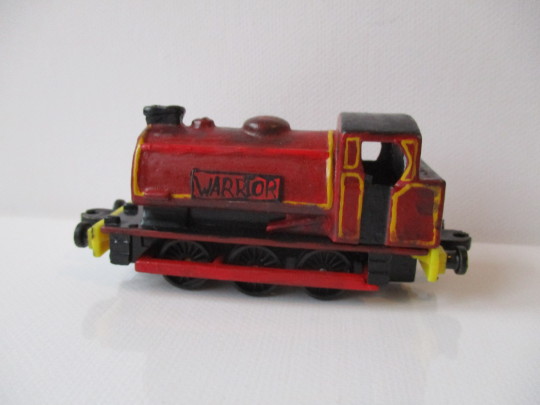
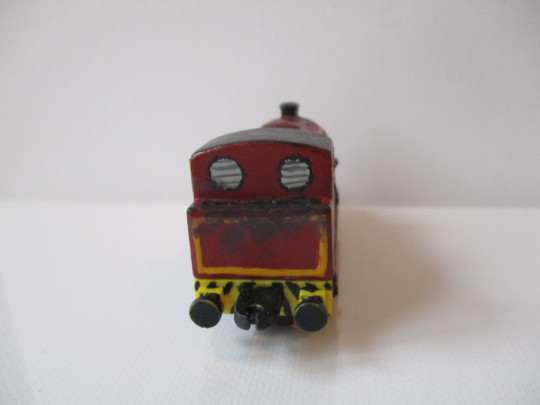
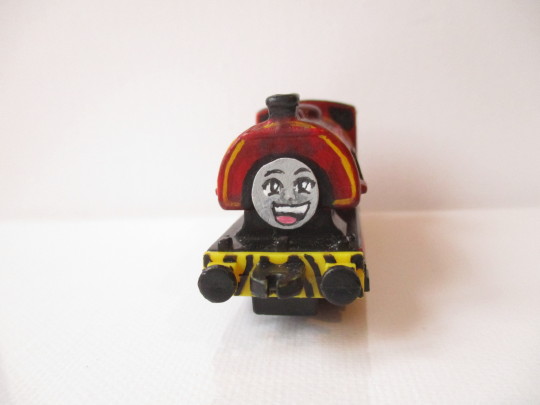
3823, Warrior, for a while Fred. An engine that chooses chaos every day. Has yet to run in preservation. She is a bit loud and willing to use force to prove her point. A true austerity.
A custom that has opened a door for me. A willingness to modify. All because I wanted to give her her Giesl Ejector style funnel.
~ Completed 18.12.2022~
#green speaks#ttte#ttte OC#OC Warrior#thomas and friends#thomas the tank engine#thomas the tank engine and friends#my art#dean forest railway#steam locomotive#locomotive
29 notes
·
View notes
Text
Hello there! Long time no see?
Before I talk about this model I do have to apologise for not uploading since my last post, life and mental health took over a lot and I just didn't have time nor motivation to post anything. However I'm going to try and make this a more constant thing rather than just whenever and whatever. I still need to plan out stuff, however I'll update you all when the time is right.
Anyway, today's model is of a locomotive I've taken some interest in, this is a 9F.
British Railways 9F class No.92250 was built at Crewe Works in 1958 and became the last steam locomotive to be fully constructed at Crewe. It was intended to be the last 9F built, and on top of that the last steam locomotive built by BR, and on technicality, if we're going off locomotive numbers, it is. However, 9F No.92220 'Evening Star' became the last 9F built and overall the Last Steam Locomotive built in 1960, by Swindon.
Despite the factor Swindon officially built the last 9F, I've never had a soft spot for Evening Star. However, after coming into ownership of a couple 9Fs, I was wondering what to do with them. The first one I got was a Single Chimney 9F which, as I have my own Railway Series Headcanon, will become some form of my Murdoch, and the second one, which was this one, was a Double Chimney Variant, but the loco only, with the tender it has coming from a Standard 5. The latter 9F was going to be a project by my friend Amethyst, known on Twitter as Merry Hampton Productions or @/B661Sutton (link at the end of post), to turn into a Double Chimney member of the class based around Tyseley.
Now, I had 251 9Fs I could have chose to turn this one into, however, as I work in Crewe, am quite local and also have taken interest into a majority of locomotives built there, I thought that 92250 would be the best fitting.
The first thing this model required was a new chimney. The later batches of 9Fs were all built with the Double chimney and blast pipe arrangement, however, 92250 was a little bit different.
In the 50s, Dr. Adolph Giesl-Gieslingen (what a name) designed and produced a type of chimney and blast pipe arrangement that would use steam more effectively which would help reduce the amount of coal an engine would intake. It was fitted to many engines in service and Preservation, a famous example being No.4 'Edward Thomas' on the Talyllyn Railway, and his Sudrian Counterpart Peter Sam.
92250 was built in 1958 and a year later in 1959 was fitted with an oblong Giesl Ejector. This chimney offered the same level of draught for a reduced level of back-pressure or created an increase in draught with no performance loss elsewhere. There was no change in the usage of coal either, so overall the chinmey made little difference to the 9Fs already stirling performance. 92250 retained this chinmey until withdrawal in 1965 and was Scrapped at Cashmores in Newport.
The chimney I used on my model of 92250 was a white metal one from RT Models. The chimney is designed to replace the ones on the Hornby Austerities and is more fit for industrial locomotives, so on the 9F it's a little bit short, however with little reference to how long it is, I removed the old one, cut down this one, and fitted it. It still looked the part however from some angles compared to pictures you can tell its a little too short.
After this the model was painted Black. For my black paint I use Revel Aqua colour. Their matt and gloss blacks have some good coverage, and as they are the colours I use most, I can go to my local Hobbycraft and pick them up easily.
After painting, I had to scrape most of the Factory Weathering off the Rods, add the numbers and Crests, which are all transfers from Fox Transfers (link to the numbers and crests bellow) and a nice coat of Humbrol Matt Varnish. I went for Matt as it was to hand and also as it would dull back the very glossy effect of the paint.
So that's all it was for 92250, a rather quick and simple project, which anyone could do as a good starter project.
Here is a link to Amethyst's twitter, where you can go and see her lovely modelling projects:
https://twitter.com/B661Sutton?t=tl58JqYScDFAOGbV-quvCw&s=09
And here is a link to the Transfers I used from Fox Transfers:
https://www.fox-transfers.co.uk/steam-cabside-numbering-3-sizes-58502
https://www.fox-transfers.co.uk/early-lion-and-wheel-totem-58306
Picture credit from below are to their respective owners on Flickr
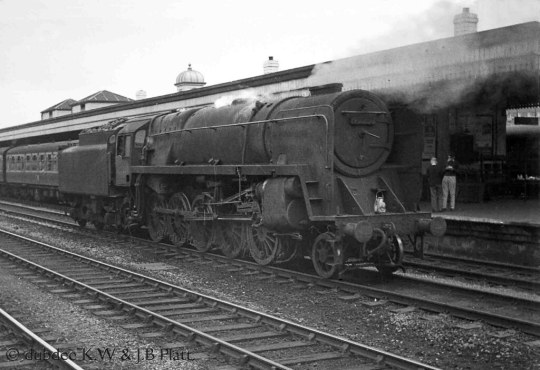

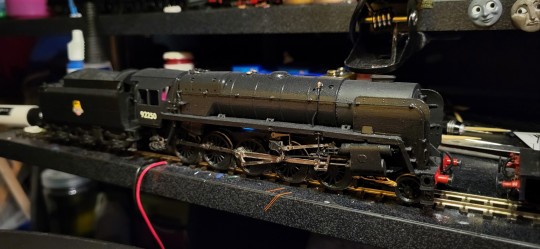
11 notes
·
View notes
Text
corris no 4

with a Giesl Ejector
it did
something
0 notes
Video
Africa Railways - Rhodesia Railways "Beyer Garratt" type 15th Class 4-6-4+4-6-4 steam locomotive Nr. 419 (Société Franco Belge, Raismes 2968 / 1951) by Historical Railway Images Via Flickr: Rhodesia Railways 15th Class 4-6-4+4-6-4 "Beyer Garratt" type steam locomotive Nr. 419, here seen fitted with an experimental Giesl exhaust ejector at Mafeking depot (South Africa) in 1970. It was built under license by Société Franco-Belge under the Raismes works number 2968 / 1951 but was also allocated Beyer Peacock (Gorton Foundry) works number 7560. RR operated the section of the Cape-to-Rhodesia route north of Mafeking, using the caboose system to accommodate relief crews over the long haul through Botswana to Bulawayo
0 notes
Text
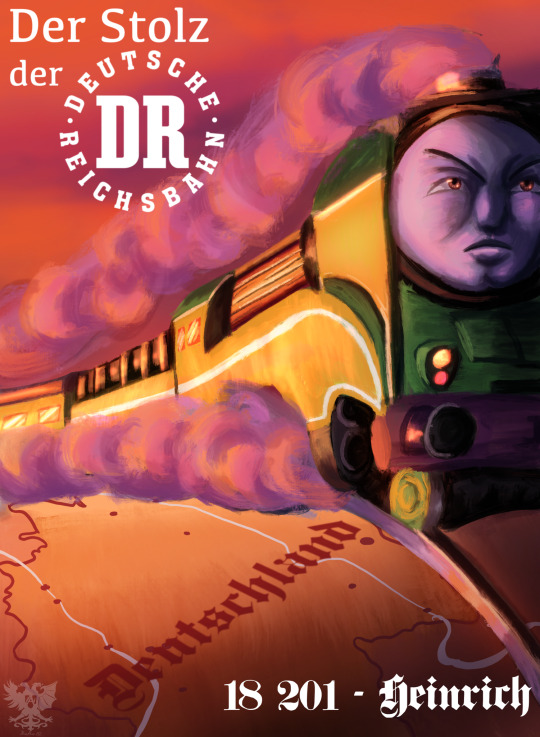
Heinrich the Pride of the DR
Dived into my archives and I present you this fast lad. This piece is inspired by an advertisement for the Rhinegold service. And the thing is 18 201 hauled those stunning looking beige and purple coaches. But he was a rarely seen on East German rails because he often hauled coaches for test runs. Because that was his purpose. That’s why most of his pictures are of him in preservation. Also he has a Giesl ejector, but in a sort of case to be proportionate to his size. The silver ring was a later addition.
#ttte#ttte oc#Heinrich the Pride of the DR#18 201#DDR steam locomotive#thomas and friends#akagi’s ocs#east germany#fake promotional poster#My favorite fast boy#Bro could leave ten minutes late and still arrive on time.#german railway#railway series
23 notes
·
View notes
Text
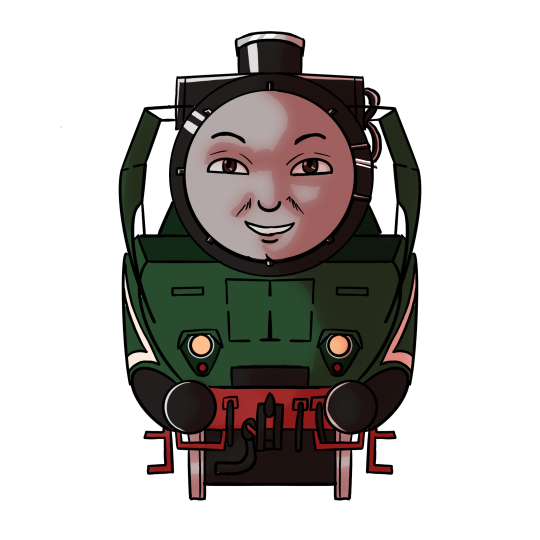
Time for a Heinrich lore dump!
Welp since I built a Lego-not-Lego model of my him I think it’s the best time to talk about my favorite fast boy Heinrich.
Heinrich is/is based on the real life preserved engine DR BR 18 201 or the number it currently wears 02 0201-0 (Which looks god awful on the smoke box imo). Heinrich’s history is basically the same, but enough chit chat it’s time for lore!
And it all starts with the VES Halle (Saale). The facility was located in the GDR (East Germany) and needed an engine to haul newly built express coaches at speeds up to 160 km/h (ca. 100mph) and beyond for testing purposes. A newly constructed Diesel for this task would have been too expensive so it was decided that the new engine was going to be a steam locomotive. For historical context in East Germany steam lasted into the 1980s.
So the project came to life, spearheaded by Dr. Baumberg from the VES. He for example is responsible for the design of streamlining which was inspired by SNCF 232.U.1. Another quirk this engine received was Giesl-Ejector. Which most of you know Peter Sam has too. In 1960 the construction began. The works responsible was the RAW Meiningen which is still operational as the Dampflokwerk Meiningen (they built Tornado’s and are involved in the P2 project). To realize Baumberg’s vision the engineers decided to attempt something. They had heard about Henry’s rebuilt at Crewe years prior. So an engine called Heinrich was brought in together with parts of two other engines and a tender from a forth engine. This original Heinrich was DRG 61 002 one of the two Henschel-Wegmann Tank engines.
They went to work and on the 31st of May 1961 their job was done. But to the shock of everyone involved behind the scenes this new engine woke up only knowing its name: Heinrich. What had gone wrong was that original Heinrich didn’t want to be so heavily altered so he basically perished, only traces of his memory remain. This has consequences for current day Heinrich. He has terrible nightmares which cause him to have bouts of insomnia. And becoming a scaredy-engine when left alone by his crew at night. But regardless this Frankenstein’s monster of an engine was not only successful but also became the fastest, in service steam locomotive in the world. The men at the VES grew fond of their new engine. They dubbed him Jimmo, because they felt like Heinrich sounded too pompous for such a chipper and friendly fella. Heinrich/Jimmo was rarely seen outside of the VES, when he was he could depart 10 minutes late and still arrive on time at his destination. Early on it was decided to give him oil firing and during the oil crisis Baumberg insisted on keeping it or he would need an army of firemen for to get Jimmo going. Because the high speed has its price, after all the three cylinders that power a set of 6 driving wheels with a diameter of 2.30 meters (ca. 7’5”) don’t power themselves. Heinrich after the end of his service life changed owners a few times. Nowadays he’s owned by the WFL and lives at Nossen which is near Dresden.
He’s revered by engines and enthusiasts alike. But he’s rather reluctant to be that famous. He only leverages his authority if an engine acts like an asshat. Heinrich has a strong sense of justice, but also a habit of being very direct. Which often results in him unintentionally trampling over the feelings of others. This brutal honesty is something Henry and Charlie like about him. Heinrich is also helpful and curious about the world. Although his curiosity occasionally results in embarrassing mishaps. Like when he chased a butterfly, demolished a set of buffers and ended up off the rails. Another quirk is that when turned on the turntable he instantly falls asleep. He and Henry become friends almost instantly. Henry helps him overcome his fear of the dark. And also influences him to become a bit more mature. Heinrich is also very respectful towards engines like Flying Scotsman and Saxonia. He even called Henry “sir” when the two green engines first met. Heinrich loves going fast. He gets ecstatic when he travels at high speeds. It’s a child like joy. He’s truly one of Germany’s finest.
#ttte#thomas and friends#ttte oc#akagi’s ocs#Heinrich the Pride of the DR#german railway#DR BR 18 201#au lore#lore dump#oc lore#Here’s the lore about my favorite fast baby#Just a precious little bean.
18 notes
·
View notes
Text
Been meaning to post recently, but time got it the way and also flew by.
However, a quick one today, and one of my Railway Series models, Stuart.
Background of Stuart: One of the Rev. W. Awdrys Charaters, Stuart was the Mid Sodor guise of Peter Sam, akin to Corris No.4 being the Corris era of Edward Thomas.
Originally I wanted to model the present day Peter Sam, with Giesl ejector chimney and in Skarloey Railway red. However, to do something with the Fourdees Kit that I hadn't seen done, I thought to do Stuart instead.
At the time Fourdees hadn't made the Corris Condition of the tattoo as a kit, so I took the Era 1 Condition of the Edward Thomas kit, chopped the buffers off, made a wooden bufferbeam out of a coffee stiring stick, and cut the running board off, filing at the more rough areas. After this he was painted in plain green and had his bufferbeams in Red, fittings in Brass and the rest in Black.
Stuart stayed in Plain Green and unlined, as I preferred him without the lining, however he didn't look right clean. As I model modern day Sodor, I thought to model the latest Condition of Stuart, which would be when the railway was slowly closing down the the engines wouldn't be looked after. I decided to weather him, and he now remains like this.
While his external condition says other wise, Stuart is one of the best running engines I have in 009 because of the Peter Sam chassis it sits on.
I do love my model of him, as its different and unique, and everyone using the Fourdees Corris condition kits, I can one up you and say I did it first 😊







19 notes
·
View notes
Video
Africa Railways - East African Railways - EAR "Beyer Garratt" type Class 60 4-8-2+2-8-4 steam locomotive Nr. 6008 "Sir Wilfrid Jackson" in Voi in 1975 (Société Franco Belge 2990 / 1953) by Historical Railway Images Via Flickr: East African Railways (meter gauge) Class 31 2-8-4 steam locomotive No. 3118 "Banyuli" was built by the Vulcan Foundry under the Newton-le-Willows works number 6249 / 1955 and later upgraded with the Giesl exhaust ejector system Standing next to it is 60th class 4-8-2+2-8-4 "Beyer Garratt" Nr. 6008 at Voi in 1975. The Governor Class Garratt was built under license by Société Franco Belge under the works number 2990 / 1953 Sister Class 60 locomotive Nr. 6006 is preserved at Nairobi Railway Museum as a static exhibit (with Sir Harold MacMichael nameplates)
0 notes
Video
Africa Railways - East African Railways - EAR "Beyer Garratt" type Class 55 4-8-2+2-8-4 steam locomotive Nr. 5505 - Nairobi, 1975 (Beyer Peacock Locomotive Works, Manchester-Gorton 7157 / 1945) by Historical Railway Images Via Flickr: East African Railways (meter gauge) Class 55 4-8-2+2-8-4 Beyer Garratt locomotive Nr. 5505 near Nairobi in 1975. It was built by Beyer Peacock under the Gorton Foundry works number 7157 / 1945 and later upgraded with the Giesl exhaust ejector system
0 notes


